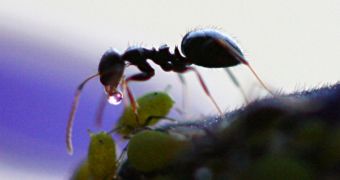The common garden ant (L. neglectus) has only been discovered in 1990, when it had already infested numerous cities throughout Europe, from the Black Sea to Germany. These insects number in the millions and are now moving north, towards Denmark, the Baltic states and the UK. There is little anyone can do about it, given the fact that they spread so quickly and are 10 to 100 times more numerous than regular ants. Their behavior ensured them a top spot on the "most dangerous pests in the world" list.
"We found that invasive garden ants developed from species in the Black Sea region that have natural populations with small networks of interconnected nests with many queens that mate underground and don't fly. It is now becoming clear that rather many ant species share this lifestyle, so that it is no surprise that a number of them have become invasive pests with giant super-colonies based on the same principles," explains Dr. Sylvia Cremer, previously a Marie Curie fellow at CSE, now a researcher at University of Regensburg, in Germany, and lead author of the new study.
When they reach a certain area, the ants multiply to such an extent that they completely wipe out all other ants in the area, as well as most species of insects. Professor Jacobus J. Boomsma, from the Center for Social Evolution (CSE) at the University of Copenhagen, in Denmark, and one of the scientists that first discovered L. neglectus, says "When I saw these ants for the first time, I simply could not believe there could be so many garden ants in the same lawn."
An international research team, composed of some 20 scientists, is currently trying to determine the area that the garden ants are now covering. Thus far, they managed to find them in countries including Romania, Bulgaria, Poland, Germany and Belgium, and there is a very distinct possibility that their areas will further expand north in the near future.
Cremer's team warns that even flowers can carry these ants, which can thus be unknowingly transported across borders, into habitats that have not yet been contaminated. Because of the nature of their nests, underground, with little outside indicators, they are very difficult to eradicate, and they can cause significant damage. In the US alone, ants are responsible for some $750 million in damages each year, despite heavy efforts authorities make to wipe them out.

 14 DAY TRIAL //
14 DAY TRIAL //